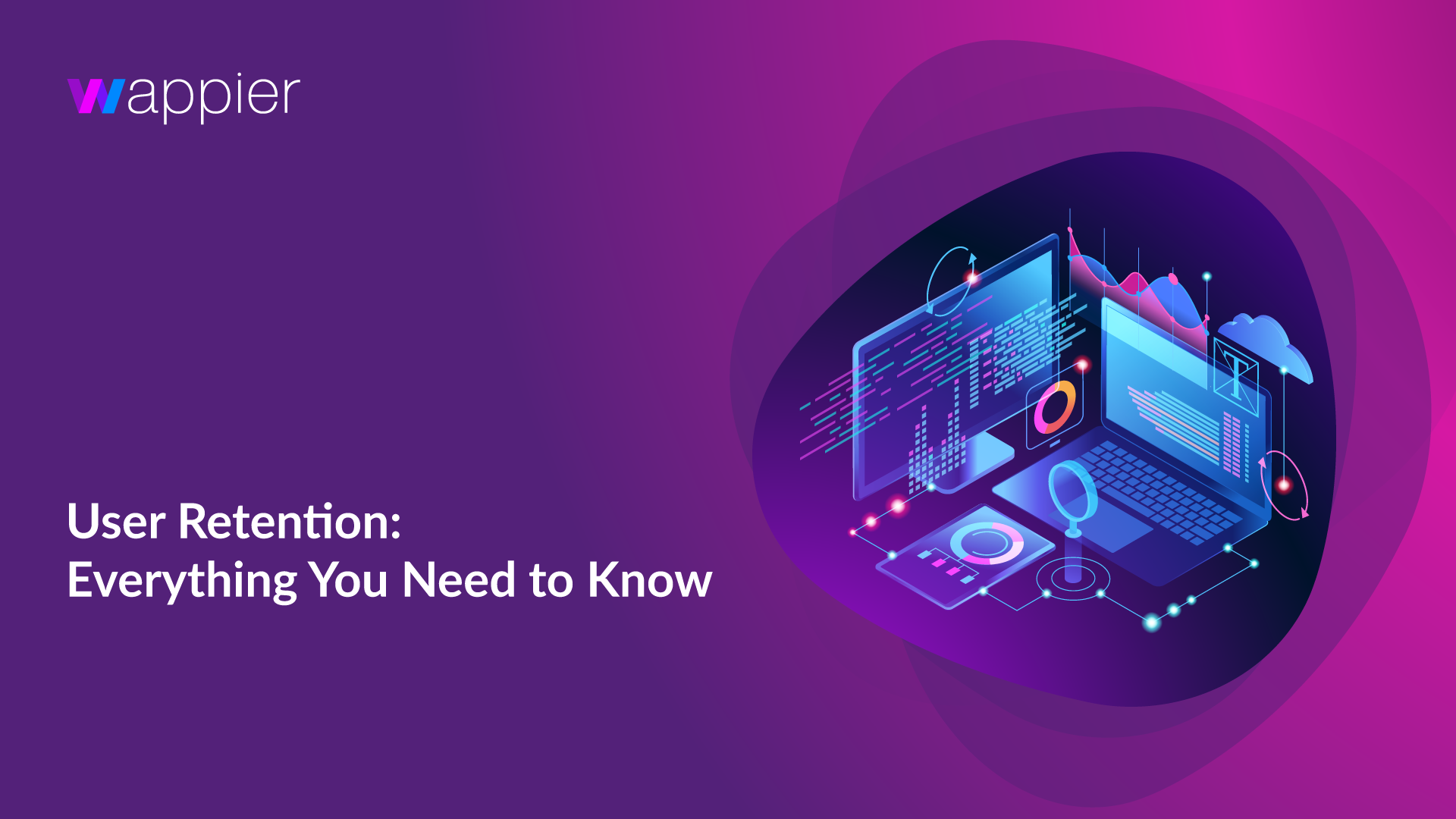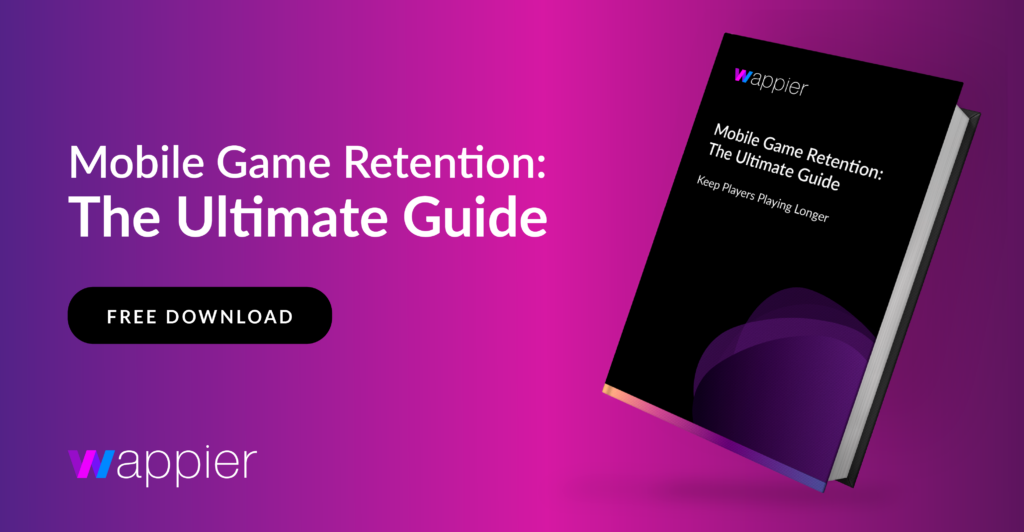While many stats help determine app success, user retention is undoubtedly one of the most important metrics for game and app developers, publishers, and marketers to analyze. User retention is not only critical for long-term profitability, but it also helps determine customer loyalty. That said, understanding, measuring, and optimizing for retention are challenging tasks for even experienced mobile professionals.
In this guide to user retention, we’ll detail what it means, how to measure it, and how to improve it. We’ll also share benchmarks and best practices to inform your strategy. Ready to get started? Let’s go!
Jump to a section…
Why Does User Retention Matter?
How Do You Measure User Retention?
What are the Benchmarks for User Retention?
What Are the Best Practices for User Retention?
Why Does User Retention Matter?
As we’ve previously discussed, retention and monetization go hand in hand. Research has shown that acquiring new users is more expensive than retaining existing users, so fostering loyalty is just good business sense.
Retention and loyalty may seem interchangeable, but while they do go hand-in-hand, there are some key differences. Retention refers to user engagement over time, while loyalty measures the relationship between the customer and the product — be it a mobile game, app, website, or even a digital product portfolio. Likewise, boosting these metrics requires different strategies; for example, adding new content and providing daily bonuses drive retention. On the other hand, things like rewards for long-term customers are what boost loyalty.
To maximize revenue and extend the lifespan of your app, you’ll want to keep a close eye on both retention and loyalty. After all, the more loyal your users are, the easier it is to retain them — and vice versa. One tool that marketers often use to measure retention is a retention curve. A retention curve is a visual representation of an app’s engaged users over time. Retention curves typically appear on charts with the percentage of returning monthly users on the Y-axis and length of time on the X-axis. More sophisticated analytics platforms can use machine learning to represent retention data in three dimensions, helping developers gain a more intuitive understanding. Regardless of how you present the data, you’ll want to get a handle on how many users are returning after that initial app download.
How to Create a Retention Curve
There are a few different ways to create a retention curve chart. However, it consistently involves collecting retention data from crucial periods — Day 1, Day 3, Day 7, and so forth — and inputting that information into a visual representation. At its core, a retention curve illustrates user loyalty by taking one of three typical shapes:
- Flattening: A flattening curve shows that a consistent percentage of users have continued to use the app over a long period. Typically this curve evens out after an initial dropoff, which is to be expected. Flattening curves can be encouraging or disappointing, depending on the percentage of users representing the curve.
- Declining: This is the kind of curve you don’t want to see. As the name suggests, declining curves represent a continuous loss of users. If declining curves are allowed to continue without intervention, the number of users will eventually reach zero. These curves are easy to recognize — unlike flattening and smiling curves, they never even out or begin to rise again.
- Smiling: You may have guessed that a smiling curve represents a positive outcome just based on its name. That’s correct! Smiling curves actually see an increase in users over time. They usually start strong, drop off a bit, and then skew back upwards, showing a recovery in user retention.
If your retention curve is in decline, there are several steps you can take to remedy the problem. Keep in mind that consumers feel affinity towards brands (and apps) they can relate to, so using relatable language is critical. Make users feel like actual people instead of just vessels for revenue. As we mentioned above, rewarding long-term users separate from daily retention bonuses is a great way of making returning users feel valued. Good customer service is one of the biggest drivers of increased loyalty, so make sure users’ issues are addressed quickly and resolved as positively as possible. And throughout all of this, make sure you’re listening to user feedback and taking it seriously.
Want to know more about retention curves and how to increase loyalty? Check out the full post: What is a Retention Curve? Understanding Loyalty Over Time.
How Do You Measure User Retention?
Along with daily active users, monthly active users, and IAP conversion, app publishers and marketers should measure retention. But it can be tricky, as retention isn’t just a single, monolithic statistic. There are nuances to measuring retention and a number of ways to conduct this analysis.
Two of the most popular methods are measuring classic retention and rolling retention. Classic retention, also known as retention by day, is a static number, calculating the percentage of steady users that have stuck around after regular intervals — Day 1, Day 7, Day 30, and so forth.
On the other hand, rolling retention is a measure of the percentage of new users who return on or after a specific day. It will change every time you calculate it. Rather than measuring retention over 30 days, for example, one might collect rolling retention metrics from November 1. If this is measured on November 4, we’re looking at an analysis of retention from November 2-3. If we wait until the end of the month, however, the rolling retention for 11/1 is measured from November 2 to November 30. Lost users are said to have “churned”.
Another key retention-related metric is churn rate or the percentage of users who abandon an app after a specified period. Ideally, app developers will see churn rates stay low while retention rates rise. If your metrics are trending in the opposite direction, it’s an indicator that you need to step up your retention efforts.
Finally, app makers should keep an eye on lifetime value, or the project value of an individual user over the course of their entire experience with an app. According to Retention Science, “Determining each individual consumer’s CLV (Customer Lifetime Value) can help you retarget your marketing efforts, retain your most valuable customers, and save you heaps of money in the long run.”
None of these metrics provide a complete picture of app retention on their own, but they provide critical insights for app developers when analyzed together. While user acquisition certainly has its place in any comprehensive app marketing strategy, it costs five times as much to acquire new users rather than retain existing users.
Learn more about user retention metrics in our blog post, Retention Metrics for Apps: What Developers Need to Measure.
What are the Benchmarks for User Retention?
Retention will vary by app category and game genre, but some universal trends make valuable reference. Organic and non-organic retention is typically neck-and-neck for the first month, after which organic users ultimately stick around longer:
- Day 1: Organic 25.2%; Non-organic 26.7%
- Day 3: Organic 13.3%; Non-organic 13.9%
- Day 7: Organic 9.1%; Non-organic 8.8%
- Day 14: Organic 6.3%; Non-organic 5.6%
- Day 30: Organic 3.8%; Non-organic 3.2%
When it comes to churn, the average three-month churn rate for apps is 72.76%. Churn is often directly related to frustrations with the app itself, including:
- In-app performance issues
- Pay-to-win game mechanics
- Rude or unfriendly community
- Too many bugs
- Not enough new content
One of the most challenging choices mobile marketers have to make is figuring out how to divide the budget between the two major mobile operating systems. Even though Android has a great market share, given that it’s on a higher number of phones from a variety of manufacturers, that doesn’t mean it should get a disproportionate chunk of the budget. iOS actually leads in retention, particularly at the Week 8 mark.
iOS retention rates:
- Day 1: 28.2%
- Day 7: 11.2%
- Day 30: 4.5%
- Week 8: 8.5%
Android retention rates:
- Day 1: 27.9%
- Day 7: 10.5%
- Day 30: 4.4%
- Week 8: 6.4%
Of course, location is also a major factor when it comes to retention benchmarks. Geographic location can result in slight variations in retention rates throughout the first month after an app is downloaded, with North American mobile users being consistently more loyal than their global counterparts.
Asia-Pacific retention rates:
- Day 1: 25.2%
- Day 3: 12.6%
- Day 7: 8.1%
- Day 14: 5.3%
- Day 30: 3.1%
Europe, Middle East, & Africa retention rates:
- Day 1: 25.3%
- Day 3: 13%
- Day 7: 8.5%
- Day 14: 5.7%
- Day 30: 3.5%
Latin America retention rates:
- Day 1: 25.9%
- Day 3: 12.7%
- Day 7: 7.9%
- Day 14: 5%
- Day 30: 2.8%
North America retention rates:
- Day 1: 26.5%
- Day 3: 13.8%
- Day 7: 8.9%
- Day 14: 5.9%
- Day 30: 3.5%
For more specific gaming and non-gaming app category breakdowns, check out The Big List of Mobile App Retention Rate Statistics.
What Are Best Practices for Mobile Game Retention?
Now that you’ve got a handle on retention, loyalty, and churn, it’s time to focus on strategy. If you’ve looked over your metrics and found app retention lacking, some universal strategies work especially well in mobile games:
- Refine the onboarding process. Many players churn right away because of dull tutorials or poorly balanced early-game difficulty. Ensure that getting started with your mobile game is a smooth, engaging process.
- Keep the content coming. Mobile players have come to expect frequent content updates. Think of launch as merely a starting point, and continue to develop expansions, new game modes, additional characters, and seasonal events.
- Stay in touch. Automated push notifications can alert players to new events or remind them to claim their daily bonuses, while in-game notifications direct players to new or timed content.
- Price it right. In an ecosystem where free-to-play reigns supreme, mobile game pricing can be extremely tricky to get right. Set price points and promotions that emphasize value.
- Use appointment mechanics. Daily login bonuses that reward players with currency or in-game items give users a reason to open the app every day. Daily quests are also effective appointment mechanics, depending on the game genre; the more habit-based engagements you can develop, the better.
Want to know more? We wrote the book on mobile game retention — check out our Mobile Game Retention: The Ultimate Guide ebook!
What Are the Best Practices for App User Loyalty?
In 2020, nearly 40,000 new apps hit the app store every month. In other words, it’s never been harder to cut through the noise and inspire the type of loyalty than leads to long-term retention and profitability. Difficult though it may be, boosting retention — and therefore loyalty — is undeniably worth it. Even a small 5% improvement in retention can increase revenue by 30% to 100%.
So what are the best ways to boost loyalty among your app users?
- Personalization: Make users feel special with personalized features. Even simple tweaks, such as addressing the user by name in the app, will show your appreciation and foster loyalty.
- Exclusive features: If you want to keep users on your app, you have to give them a reason to be there. Exclusive features, offers, and prizes incentivize users to choose your app over the competition, a tactic used effectively by brands like Hilton and Target.
- Loyalty programs: Few tactics are as proven as retail reward programs, and this goes for apps as well. Design programs for long-term users that offer virtual rewards, exclusive discounts, and other cumulative bonuses. These should be separate from the daily bonuses discussed in a previous section.
- Customer service: Brands like Zappos and Apple have built their reputations on stellar customer service, and it’s just as important when thousands of apps are vying for users’ attention. Open, two-way communication is key. Users respond positively to publishers that go above and beyond when things go right and when they don’t.
Want to learn more? Read the full article: Mobile Retention – 6 Ways to Maximize User Loyalty in 2021.
It’s a Marathon, Not a Sprint
Even the biggest publishers struggle with app retention. Getting users to come back day after day, year after year, takes a lot of patience. You’ll need data, analysis, and strategy to make sure every part of your app, from onboarding to communications to content, is working as intended to boost loyalty. When it all clicks, it’s worth it to have ultimately increased your users’ lifetime value — and that of the app itself.
If you’re not sure where to start, we can help! With powerful AI that analyzes over two billion data points every day, wappier goes beyond typical marketing automation by helping app developers and publishers leverage comprehensive analytics and optimize their apps. Want to know more about how wappier can help you increase user retention? Contact the experts today!







